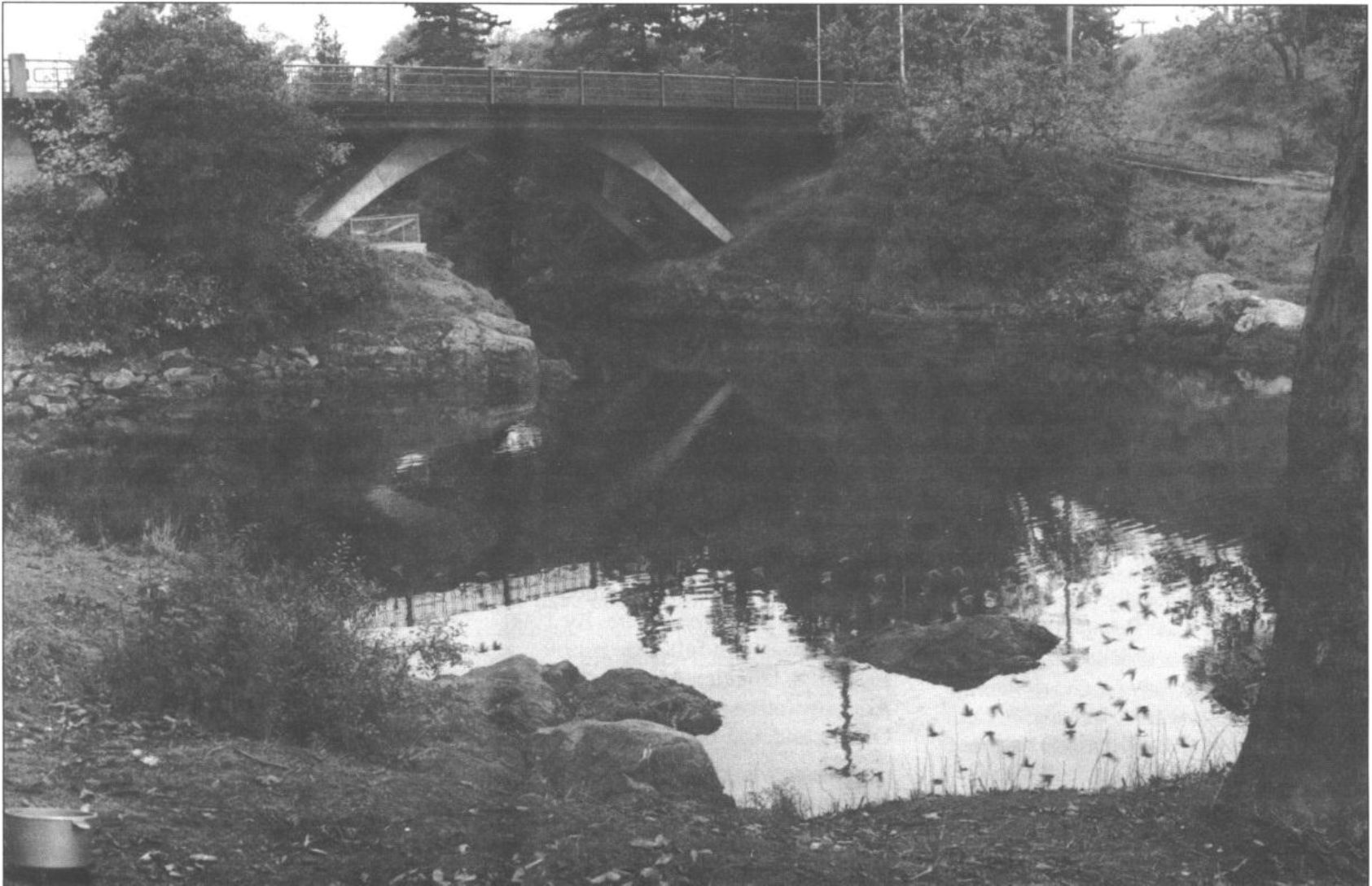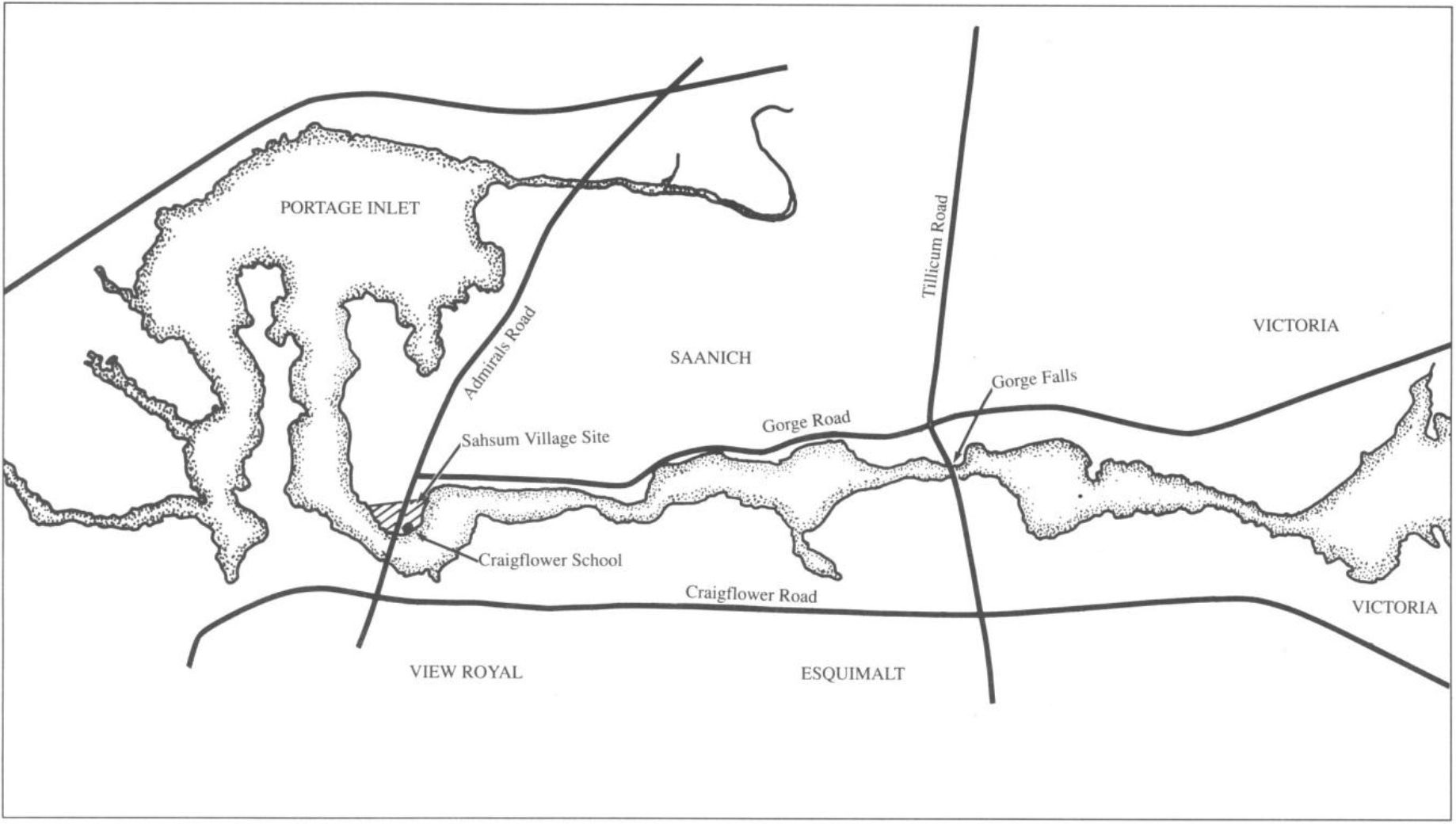Originally published in: Discovery: Friends of the Royal British Columbia Museum Quarterly Review, 4(5).
By Grant Keddie. Autumn 1991.
Introduction
The location of the reversible falls on the Gorge waterway in Victoria is significant in the history of Vancouver Island’s Songhees Indians.
The legend of this beautiful spot under the Tillicum Road bridge produced the name of the city’s Camosun College, and was the first name for the Victoria area used by both Indians and fur traders. In 1843, James Douglas of the Hudson’s Bay Company referred to the waterway from Victoria Harbour to Portage Inlet as “Camosack”. The new fur-trade post was called “Fort Camosack”, and then “Fort Albert”, before it officially became “Fort Victoria”. Camosack was an interpretation of the native name that was pronounced “Camossung”, but in the early days of the fort, “Camosun” came into common usage.
In 1905, when names were being proposed for a new Canadian Pacific Railway hotel in Victoria, an anonymous person suggested it be called Camosun Hotel: “More than any other it is associated with this place, because as Fort Camosun it is, or was, the foundation of our own town, and is the name given by the Indians to the Gorge, which means according to that high authority, the late Mr. J.W. Mckay, of the Hudson’s Bay Company and Indian Department, the ‘cut’ or gorge through which the upper waters are discharged into the Arm. It may not be out of place to say that it is properly pronounced with a slight accent on the second syllable.” Camosun was not chosen as the name of the CPR hotel – it was called the Empress.
In Songhees tradition, Camossung was a Spirit Being connected to the area of the reversible falls. At the falls, a little girl named Camossung, who was squatting in the water, and her grandfather, Snukaymelt (“diving”), were turned to stone. The stones could once have been seen under the water facing up the Gorge. Two stone figures were said to rise and fall with the level of the water, but never came to the surface.
This is a sacred place where people sought spirit powers. On this spirit quest, persons would jump into the water below the falls, holding a rock to take them to the bottom, until Camossung took pity and granted the powers they sought. It was believed that only persons who practised regular spirit-cleaning rituals would gain the powers necessary to acquire success in life.
In the early nineteenth century, the Songhees people were under the constant threat of war raids. They retreated up the Gorge to Portage Inlet in the territory of one of their tribal groups called the Sahsum, whose village was located where the old Craigflower school and the Tillicum school are today. Here, it was believed, Camossung would protect her people from their enemies. The Camosun story is in several fragmented versions. An outline of one was recorded in 1950 by anthropologist Wilson Duff from


The Story of Camossung
Songhees band member Jimmy Fraser (born in 1871) who was the grandson of Chee-al-thluc, or “King Freezy”, the head Songhees chief at the time of the founding of “Fort Camosack”. The story is as follows:
“After the Flood when Raven, Mink and the Transformer Hayls were travelling around teaching the people how things were to be done, they came to this place, and found a young girl and her grandfather. The girl, Camossung, was sitting in the water, crying. ‘Why are you crying?’ asked Hayls. ‘My father is angry with me, and won’t give me anything to eat.’ ‘What would you like?’ he asked. ‘Sturgeon?’ ‘No.’ ‘Berries?’ ‘No.’ She refused a lot of things, and that is why they are not found along the Gorge. ‘Duck? Herrings? Coho? Oysters?’ These she accepted, and that is why they are plentiful here. ‘You will control all of these things for your people,’ said Hayls. Then he turned her into stone…. Since she liked her grandfather to be with her, he was also turned to stone, as if jumping in carrying a rock to take him to the bottom.”
Five years after Duff recorded the above version, a newspaper interview with Jimmy Fraser gave a different version, stating that Camossung and her grandfather lived on the site of the old Craigflower school. “A flood came and destroyed their home site and left them starving. They wandered along the banks of the Gorge looking for food but could find none… . [Camossung] pleaded to the Songhees god, the sun, to provide her with food, and the kindly god responded to her pleadings. The god leaned down and offered sturgeon. The girl said she did not like fish, so the god gave it a mighty heave and it landed somewhere on the mainland. Then the god offered cranberries and again she refused, so the god threw them to an area around Shawnigan Lake. As punishment for her greed the god took a handful of water from the Gorge, sprinkled it on her, turning her to stone.”
A 1963 interview with Jimmy Fraser includes further information: “Camosun, with the welfare of her people in mind, asked Kalis for trees which would ‘clutch the sky’, flowers to cover the rocks, a good harbour to protect the canoes of the tribe and for milder and warmer winds.
“Kalis promptly changed some of her people into trees known today as Garry Oaks. He transformed others into flowers, such as blue camas and the Easter Lily, and bade the northwest wind warrior spirit not to deal too harshly with the land of Camosun. He made the harbour and the Gorge inland waterway next.”
Another story said that “Indian women believed garments washed in the foam from the falls protected them from drowning. As they worked they crooned a mournful tribal chant to appease the god of water… . Superstition among them was that if a man was sick, when the water was flowing inland he would recover. But if the current was seaward he would die.”
According to Jimmy Fraser, “the head of the grandfather [stone] was removed during construction of the present [pre-1967] Gorge bridge”. Fraser explained that “two men died because they touched the grandfather’s head while paddling their boats through the passage in earlier days”. Camossung was angered when the men struck her aged grandfather, and created dangerous whirlpools that turned the boats over, drowning the men. That is why there are whirlpools there now. It was claimed that a boatrental operator dynamited the rocks to make a safer passage for boats.
Today, hundreds of fishermen eagerly catch herring from the Tillicum bridge, not knowing that the Songhees once caught runs of coho and chum salmon, as well as plenty of cutthroat trout. Maybe with a little cleansing of our spirits. Camosun will help us in protecting this beautiful spot and its cherished resources.
